Abstract
Recognition of Campylobacter fetus subsp. jejuni (referred to hereafter as C. jejuni) as an important human pathogen and its isolation from meat products indicate the need for knowledge of its survival characteristics in meats. Thermal death times (D-values) for a single strain and a five-strain composite were determined in 1% peptone and autoclaved ground chicken meat at temperatures ranging from 49 to 57 degrees C. Survival was determined for these strains in chicken meat at 4, 23, 37, and 43 degrees C. Survival was also determined on raw chicken drumsticks stored at 4 degrees C in either an ambient or a CO2 atmosphere. D-values were greater in chicken meat than in peptone in all cases. D-values in peptone for strain H-840 at 49, 51, 53, 55, and 57 degrees C were 15.2, 4.90, 1.71, 0,64, and 0.25 min, respectively. The corresponding D-values in ground chicken meat were 20.5, 8.77, 4.85, 2.12, and 0.79 min, respectively. Similar results were obtained with a composite of five strains. When sterile ground chicken meat was inoculated with approximately 10(6) to 10(7) C. jejuni cells per g and stored at 37 degrees C in an ambient atmosphere, a 1-to 2-log count increase occurred during the first 4 days, followed by a gradual decline of about 1 log during the remainder of the 17-day storage period. No growth was observed among similarly inoculated samples that were stored at 4, 23, and 43 degrees C but counts declined by about 1 to 2 logs at 4 degrees C (17 day), by 2.5 to 5 logs at 23 degrees C (17 days), and to undetectable levels at 43 degrees C (between 10 and 16 days). Survival on raw chicken drumsticks stored at 4 degrees C in CO2 and in an ambient atmosphere declined by about 1.5 and 2.0 logs, respectively, during 21 days of storage. The effect of temperature on the survival of C. jejuni in chicken meat was similar to that reported in other natural and laboratory milieus. Ordinary cooking procedures that destroy salmonellae would be expected to destroy C. jejuni.
Full text
PDF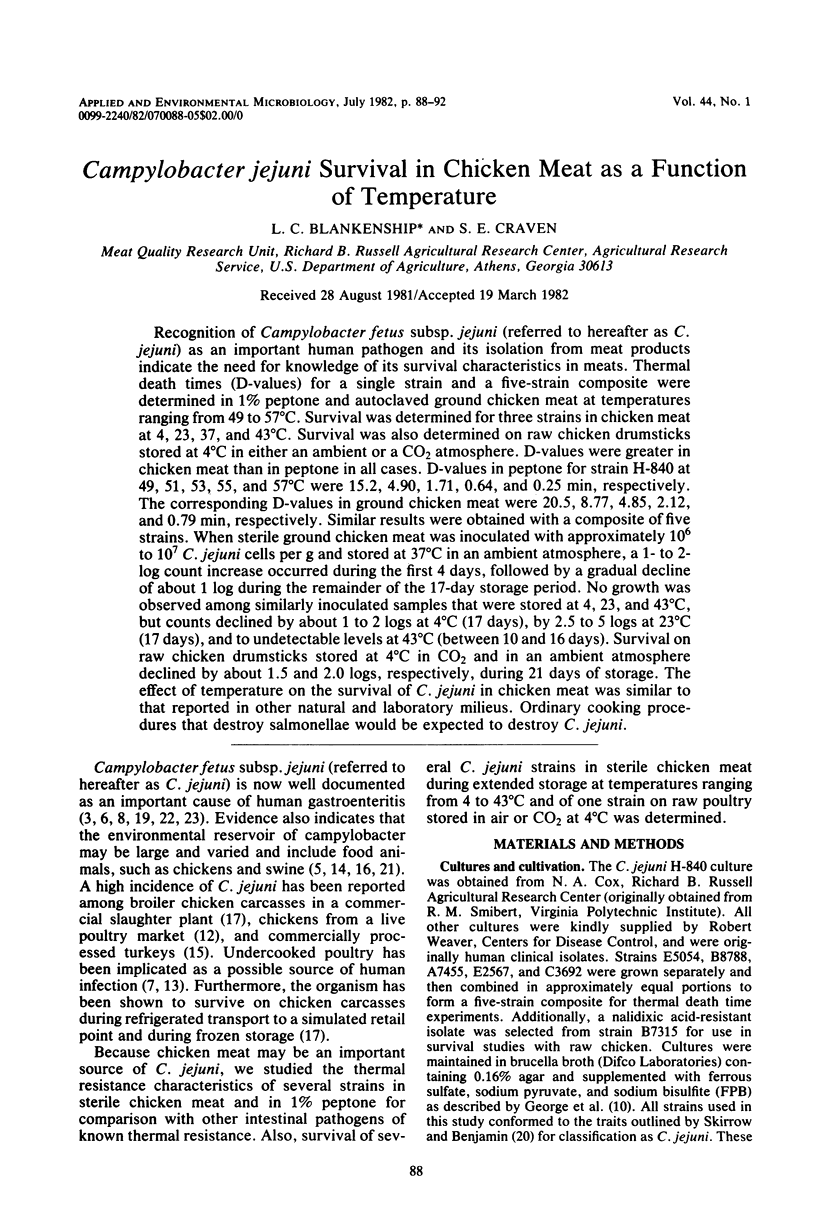
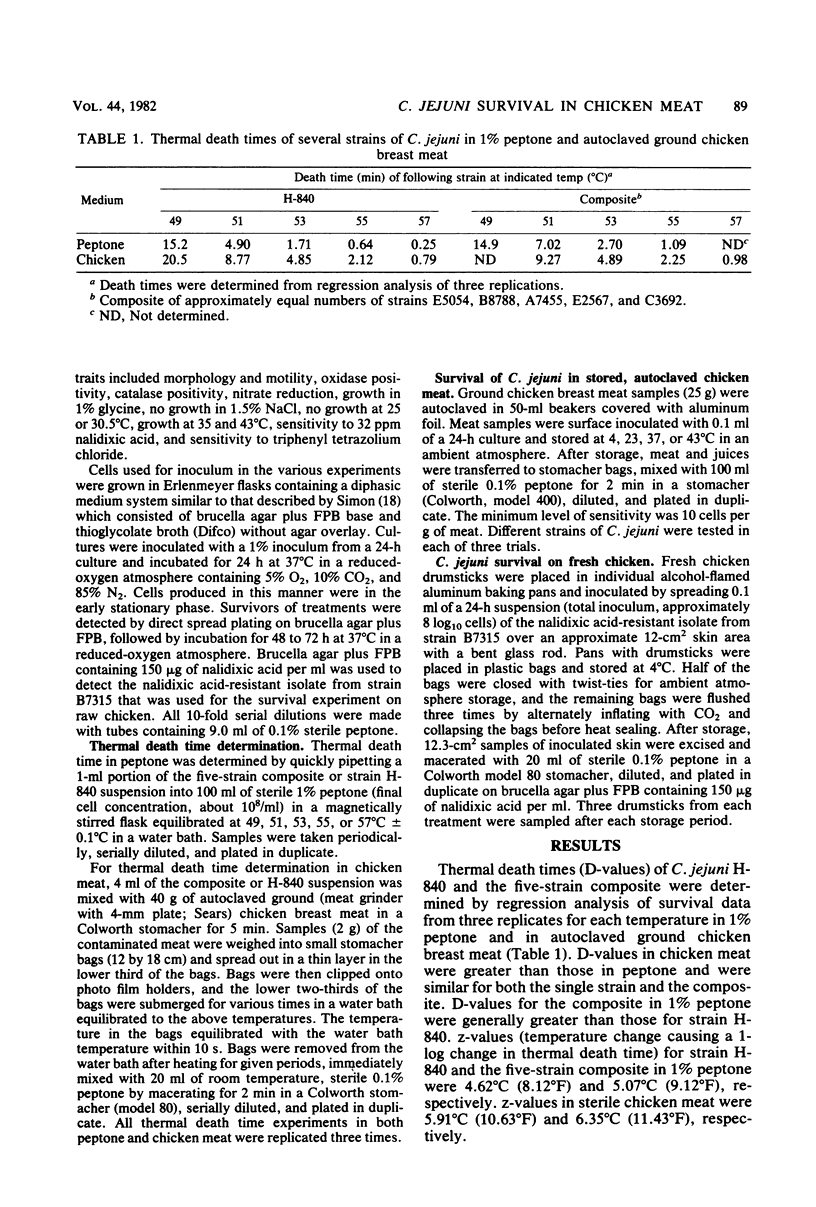
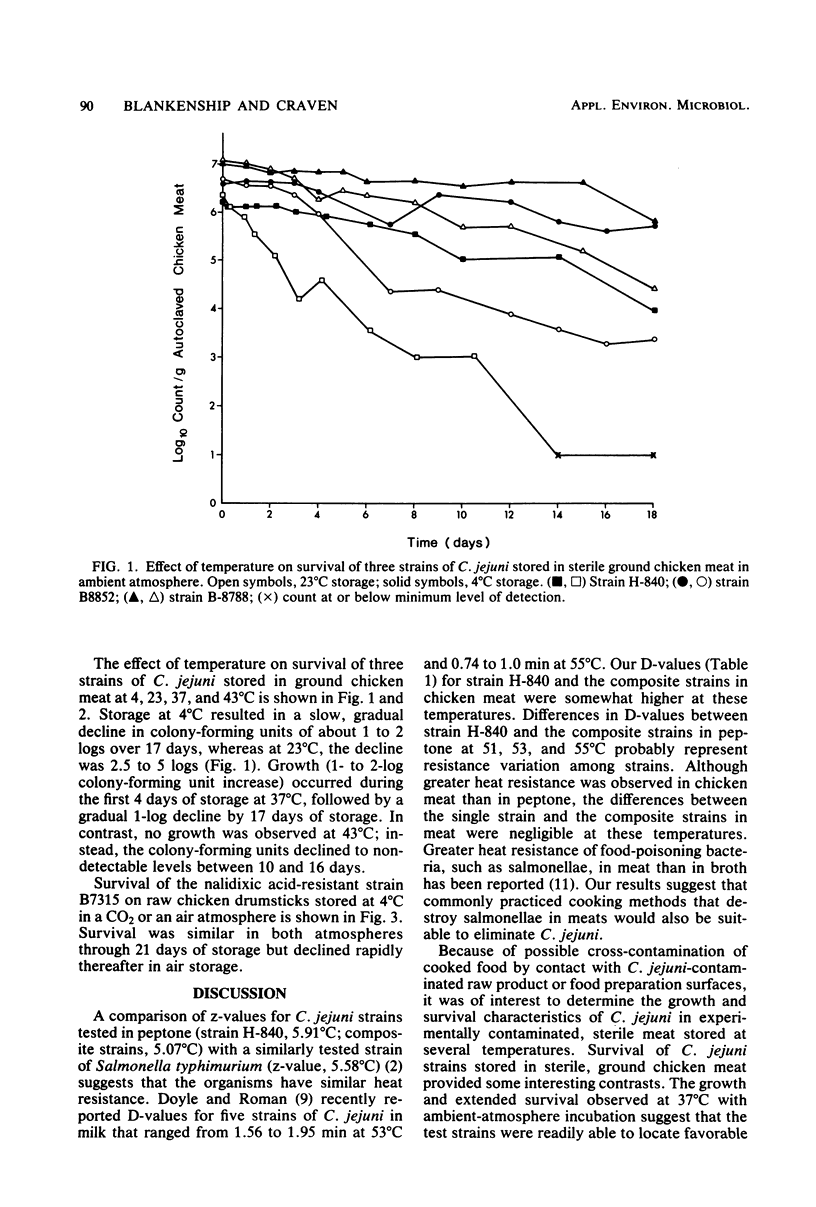
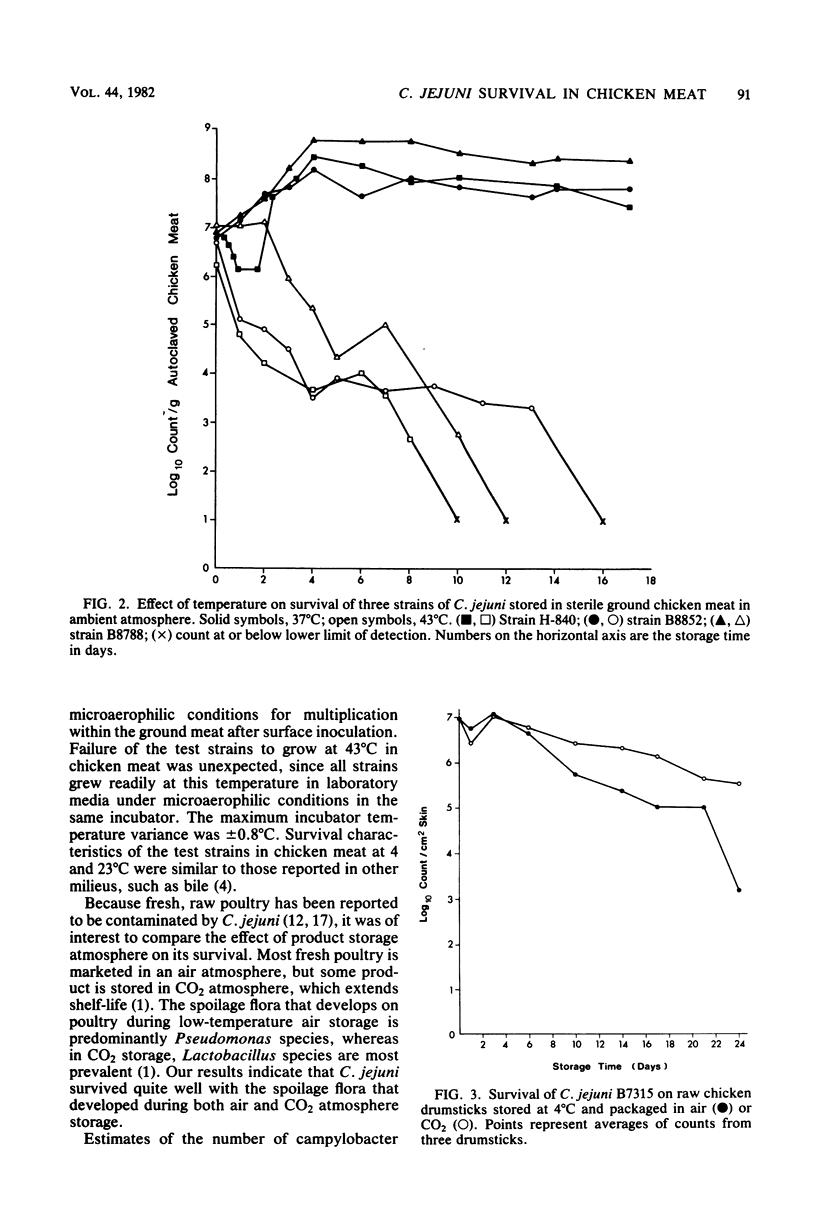
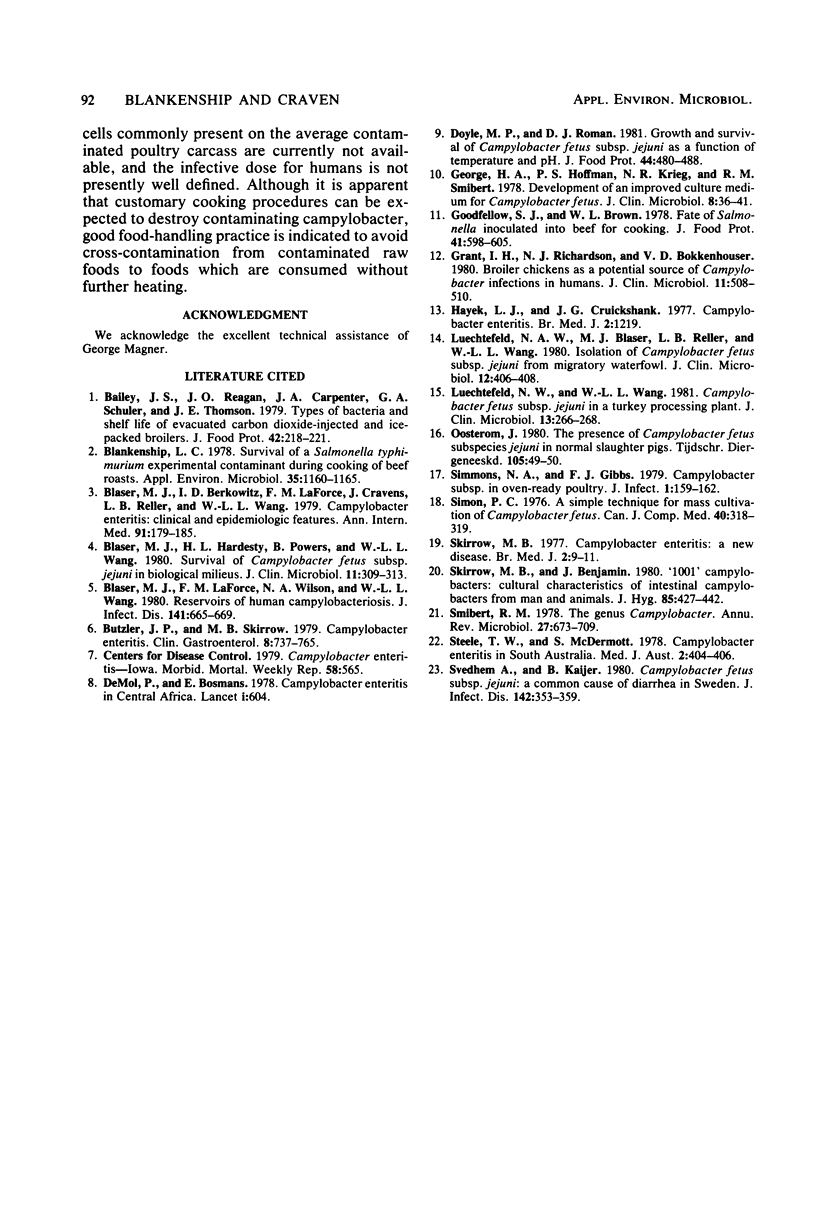
Selected References
These references are in PubMed. This may not be the complete list of references from this article.
- Blankenship L. C. Survival of a Salmonella typhimurium experimental contaminant during cooking of beef roasts. Appl Environ Microbiol. 1978 Jun;35(6):1160–1165. doi: 10.1128/aem.35.6.1160-1165.1978. [DOI] [PMC free article] [PubMed] [Google Scholar]
- Blaser M. J., Berkowitz I. D., LaForce F. M., Cravens J., Reller L. B., Wang W. L. Campylobacter enteritis: clinical and epidemiologic features. Ann Intern Med. 1979 Aug;91(2):179–185. doi: 10.7326/0003-4819-91-2-179. [DOI] [PubMed] [Google Scholar]
- Blaser M. J., Hardesty H. L., Powers B., Wang W. L. Survival of Campylobacter fetus subsp. jejuni in biological milieus. J Clin Microbiol. 1980 Apr;11(4):309–313. doi: 10.1128/jcm.11.4.309-313.1980. [DOI] [PMC free article] [PubMed] [Google Scholar]
- Blaser M. J., LaForce F. M., Wilson N. A., Wang W. L. Reservoirs for human campylobacteriosis. J Infect Dis. 1980 May;141(5):665–669. doi: 10.1093/infdis/141.5.665. [DOI] [PubMed] [Google Scholar]
- Butzler J. P., Skirrow M. B. Campylobacter enteritis. Clin Gastroenterol. 1979 Sep;8(3):737–765. [PubMed] [Google Scholar]
- De Mol P., Bosmans E. Campylobacter enteritis in Central Africa. Lancet. 1978 Mar 18;1(8064):604–604. doi: 10.1016/s0140-6736(78)91044-9. [DOI] [PubMed] [Google Scholar]
- George H. A., Hoffman P. S., Smibert R. M., Krieg N. R. Improved media for growth and aerotolerance of Campylobacter fetus. J Clin Microbiol. 1978 Jul;8(1):36–41. doi: 10.1128/jcm.8.1.36-41.1978. [DOI] [PMC free article] [PubMed] [Google Scholar]
- Grant I. H., Richardson N. J., Bokkenheuser V. D. Broiler chickens as potential source of Campylobacter infections in humans. J Clin Microbiol. 1980 May;11(5):508–510. doi: 10.1128/jcm.11.5.508-510.1980. [DOI] [PMC free article] [PubMed] [Google Scholar]
- Luechtefeld N. A., Blaser M. J., Reller L. B., Wang W. L. Isolation of Campylobacter fetus subsp. jejuni from migratory waterfowl. J Clin Microbiol. 1980 Sep;12(3):406–408. doi: 10.1128/jcm.12.3.406-408.1980. [DOI] [PMC free article] [PubMed] [Google Scholar]
- Luechtefeld N. W., Wang W. L. Campylobacter fetus subsp. jejuni in a turkey processing plant. J Clin Microbiol. 1981 Feb;13(2):266–268. doi: 10.1128/jcm.13.2.266-268.1981. [DOI] [PMC free article] [PubMed] [Google Scholar]
- Oosterom J. Het voorkomen van Campylobacter fetus subspecies jejuni bij normale slachtvarkens. Tijdschr Diergeneeskd. 1980 Jan 1;105(1):49–50. [PubMed] [Google Scholar]
- Simon P. C. A simple technique for mass cultivation of Campylobacter fetus. Can J Comp Med. 1976 Jul;40(3):318–319. [PMC free article] [PubMed] [Google Scholar]
- Skirrow M. B., Benjamin J. '1001' Campylobacters: cultural characteristics of intestinal campylobacters from man and animals. J Hyg (Lond) 1980 Dec;85(3):427–442. doi: 10.1017/s0022172400063506. [DOI] [PMC free article] [PubMed] [Google Scholar]
- Skirrow M. B. Campylobacter enteritis: a "new" disease. Br Med J. 1977 Jul 2;2(6078):9–11. doi: 10.1136/bmj.2.6078.9. [DOI] [PMC free article] [PubMed] [Google Scholar]
- Smibert R. M. The genus Campylobacter. Annu Rev Microbiol. 1978;32:673–709. doi: 10.1146/annurev.mi.32.100178.003325. [DOI] [PubMed] [Google Scholar]
- Steele T. W., McDermott S. Campylobacter enteritis in South Australia. Med J Aust. 1978 Oct 21;2(9):404–406. doi: 10.5694/j.1326-5377.1978.tb76814.x. [DOI] [PubMed] [Google Scholar]
- Svedhem A., Kaijser B. Campylobacter fetus subspecies jejuni: a common cause of diarrhea in Sweden. J Infect Dis. 1980 Sep;142(3):353–359. doi: 10.1093/infdis/142.3.353. [DOI] [PubMed] [Google Scholar]


